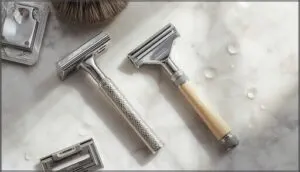This site is supported by our readers. We may earn a commission, at no cost to you, if you purchase through links.
Most people don’t realize that up to 78% of shaving-related skin issues stem from technique rather than tools. You might blame your razor for those red bumps and nicks, but the real culprit is often how you’re using it.
Safe leg shaving practices aren’t just about avoiding cuts—they protect your skin barrier, prevent infection, and keep your legs smooth without the aftermath of irritation. The difference between a comfortable shave and days of razor burn comes down to a few key steps that most people skip.
From the temperature of your water to the direction of your strokes, small adjustments create dramatically different results. Understanding what actually happens to your skin during shaving helps you avoid common mistakes and build a routine that works with your body, not against it.
Table Of Contents
Key Takeaways
- Most shaving irritation comes from poor technique rather than your razor—up to 78% of skin issues stem from how you shave, not what you use.
- Preparing your skin properly matters: warm water softens hair by 45%, reducing nicks and irritation, while timing your shave at night gives smoother results as skin stays relaxed.
- Sharp blades are essential for safe shaving—replace your razor every 5-7 shaves since dull blades increase friction, cause more passes over skin, and dramatically raise your risk of razor burn and ingrown hairs.
- Post-shave care directly prevents problems: moisturizing immediately after shaving cuts irritation by 37%, boosts water retention for 8+ hours, and cold water rinses reduce razor burn risk by closing pores and calming inflammation.
Preparing Your Legs for Safe Shaving
Think of shaving prep like laying the groundwork before painting—you can’t skip the surface work and expect smooth results. Your skin and hair need the right conditions before a razor ever touches them.
Here’s how to set yourself up for a comfortable, irritation-free shave.
Hydrating Skin and Softening Hair
Before you reach for your razor, hydrating your skin makes a real difference. Warm water opens pores and softens hair by up to 45%, cutting down on nicks and irritation.
Here’s what works:
- Soak your legs in warm water for a few minutes
- Use shaving creams with humectants like hyaluronic acid
- Apply moisturizing shaving gel to create a protective barrier
- Skip hot water—it strips natural oils
- Try water-based wipes when water isn’t available
Washing beforehand creates a cleaner shaving canvas, minimizing irritation. Proper skin hydration before shaving reduces razor burn and keeps your moisture barrier intact.
Timing Shaves for Best Results
Once your skin is prepped, timing your shaving routine matters more than you’d think. Shaving legs at night gives you smoother results—your skin stays warm and relaxed, and any missed hairs retract overnight.
For shaving frequency, aim for every 2-3 days to balance smoothness with skin health. For a closer shave, follow guidelines for shaving sensitive areas.
Athletes might time shaves before events since reducing hair lowers skin resistance during performance.
Choosing and Applying Shaving Cream or Gel
After you’ve timed your shave right, product selection makes a real difference. Shaving gel glides smoothly with clear visibility, while shaving cream offers richer moisture for dry skin.
Application techniques matter—apply generously to damp legs, letting it sit briefly to soften hair.
For ingredient considerations, choose fragrance-free products if you’re prone to irritation. Proper skin hydration starts here, setting you up for a comfortable, nick-free shave.
Choosing The Right Razor and Tools
The razor you pick can make or break your shaving routine. Different tools offer different benefits, and knowing what works for your skin helps you avoid nicks and irritation.
Let’s look at the main options and what you need to know about keeping your blades in top shape.
Safety Razors Vs. Cartridge Razors
Choosing between safety razors and cartridge razors affects your shaving experience in several ways. Here’s what you need to know:
- Skin sensitivity: Safety razors cause less redness (40.3% versus 57.6% immediately after shaving) because their single blade requires fewer passes across your skin.
- Cost comparison: Safety razor blades cost about 10 cents per shave, while cartridge replacements run $2-$5 each.
- Environmental impact: Safety razors produce considerably less plastic waste since you only replace metal blades.
Both deliver smooth results with proper shaving techniques and sharp razor blades.
Pros and Cons of Electric Razors
Electric razors can slash your shaving time by 66% and cut nick risk by 75% compared to traditional razors. However, they cost $100–$300 upfront, and 41% of users with sensitive skin still experience irritation. Consider these trade-offs:
| Factor | Electric Razors | Manual Razors |
|---|---|---|
| Shaving Closeness | Slightly less smooth | Very close results |
| Skin Irritation | Lower cut risk, moderate redness | Higher cut risk possible |
| Upfront Cost | $100–$300 initially | $10–$30 per razor |
| Environmental Impact | CO2 emissions from electricity | Less energy, more plastic waste |
| Battery Life | Recharge needed, degrades in 2–5 years | No charging required |
Your skin type and budget determine which razor works best for your legs.
Blade Sharpness and Replacement
When your razor blade loses its edge, you’ll notice it tugging instead of gliding smoothly. Replace your razor every 5–7 shaves to maintain peak sharpness and prevent irritation.
A sharp razor requires fewer passes, reducing your risk of nicks and ingrown hairs. Dull blades increase friction, causing redness and razor burn.
Check your blade’s coating quality—fading lubricating strips signal it’s time for a fresh replacement.
Effective and Gentle Shaving Techniques
Once you’ve got the right razor in hand, your technique makes all the difference between smooth results and irritated skin. How you move the blade, the angle you use, and the care you take during the shave directly affect whether you’ll end up with nicks or redness.
Let’s walk through the specific methods that help you shave gently and safely every time.
Shaving in The Direction of Hair Growth
Think of shaving with the grain like petting a cat—go the right way, and everything stays smooth. Shaving in the direction of hair growth is one of the safest techniques to reduce irritation and minimize erythema. Here’s why it works:
Shaving with the grain, like petting a cat the right way, is the safest technique to reduce irritation and keep skin smooth
- Cuts fewer hairs below the skin surface
- Lowers your risk of razor burn considerably
- Prevents ingrown hairs more effectively
- Reduces inflammation and redness
- Promotes faster skin recovery after shaving
Statistical findings show that shaving leg hair with the grain decreases skin inflammation markers. Your hair appearance won’t change—hair growth rates stay the same regardless of shaving technique.
Avoiding Nicks, Cuts, and Irritation
Safety first: the secret to avoiding razor burn, nicks, and cuts lies in your technique. Use gentle strokes with light pressure—think caressing, not scraping. Rinse your razor every few strokes to prevent buildup.
Limiting passes over the same area protects against microtrauma. These shaving leg techniques reduce irritation considerably. Slow, steady movements keep your skin smooth and healthy.
Rinsing and Caring for Your Razor During Shave
Your razor works best when you keep it clean between strokes. Rinsing frequency matters—clear away hair, cream, and dead skin after each pass under warm running water to maintain blade sharpness.
Proper razor maintenance during your shave includes:
- Rinse under warm water after every stroke
- Tap gently against the sink to dislodge debris
- Check between blades for stubborn buildup
- Shake off excess water before continuing
This simple blade replacement prevention keeps your shaving smooth and irritation-free.
Post-Shave Skin Care Essentials
What you do after shaving matters just as much as the shave itself. Your skin needs immediate care to recover from the friction and minor trauma of hair removal.
Let’s cover the essential steps that help your legs feel smooth, calm, and irritation-free.
Moisturizing to Soothe Skin
Shaving strips away natural oils and disrupts your skin’s protective layer. That’s why you need to moisturize right after—it restores hydration and speeds barrier repair.
Studies show post-shave moisturizer boosts water retention for over eight hours and cuts irritation by 37%.
Choose fragrance-free formulas with ceramides or hyaluronic acid. They lock in moisture, prevent dry skin, reduce razor bumps by 28%, and shield against environmental stressors.
Using Aftershave Balms and Cold Water
Your skin barrier needs more than just moisturizer after shaving. Cold water benefits start with closing pores and reducing inflammation—it’s a natural astringent that prevents bacterial invasion. Follow up with an aftershave balm containing aloe vera or chamomile to calm irritation and lock in hydration. This postshave care combo cuts razor burn risk considerably.
Application techniques for best results:
- Rinse legs thoroughly with cool water immediately after your final razor stroke
- Pat skin semi-dry, then apply balm using gentle upward strokes
- Let the product absorb for two minutes before dressing to optimize skin barrier protection
Preventing Razor Burn and Redness
Razor burn stems from inflammation—irritant contact dermatitis triggered by shaving techniques for legs that create too much friction.
Managing razor burn starts with blade maintenance: dull razors worsen redness by 40% compared to sharp ones. Use light shaving pressure, choose products with anti-inflammatory ingredients like aloe, and apply cooling methods post-shave.
Exfoliation benefits include preventing buildup that traps bacteria, reducing your inflammation risk considerably.
Preventing and Managing Common Shaving Issues
Even with careful technique, shaving can sometimes lead to irritation, bumps, or ingrown hairs. These issues aren’t just uncomfortable—they can make you hesitant to shave at all.
Let’s look at practical ways to prevent these problems and manage them if they do show up.
Avoiding Ingrown Hairs
When hair curls back into your skin instead of growing outward, you’re dealing with ingrown hairs. Here’s how to keep them at bay:
- Shave with hair growth direction – Going against the grain creates sharp edges that pierce skin more easily.
- Exfoliate regularly – Exfoliation benefits include clearing dead cells that trap hairs underneath.
- Consider shaving frequency – Too-close shaves increase risk; leave slight stubble.
- Explore alternative methods – Professional waxing might work better for curly hair types.
Minimizing Razor Burn and Bumps
Beyond ingrown hairs, razor burn creates that painful red rash you want to avoid. Start with gentle pressure—pressing hard increases skin irritation by 21%. Exfoliation benefits include removing dead cells that worsen bumps.
After shaving, apply post-shave compresses using cool water for five minutes to reduce redness by 20%.
Your hair texture matters too—curly types see 60% more razor burn, so avoiding irritants like alcohol-based products helps achieve smooth skin.
Shaving Tips for Sensitive or Problem Skin
When you have sensitive skin, your shaving routine needs extra attention. Dermatologist advice on shaving starts with these shaving tips:
- Check product ingredients—avoid alcohol and synthetic dyes to cut inflammation by 45%
- Apply pre-shave oils to boost hydration by 25%
- Follow shaving direction with hair growth to reduce skin irritation 50%
- Practice razor maintenance and post-shave exfoliation regularly
Frequently Asked Questions (FAQs)
How often should I replace my razor?
Ironically, that trusty razor you’ve been using too long is probably causing more harm than help.
Replace your razor blades every 5 to 7 shaves to maintain blade sharpness and avoid hygiene risks like infection.
Can I share razors with family members?
No, you shouldn’t share razors with family members. Razor blades can harbor bacteria and bloodborne viruses like Hepatitis B or C, creating serious infection transmission risks through micro-cuts in your skin.
What should I do if I cut myself?
Even the steadiest hand can slip. First, apply gentle pressure with clean gauze to stop bleeding.
Rinse with cold water, use a styptic pencil, then apply topical antibiotics to prevent infection and promote proper wound care.
Is it safe to shave during pregnancy?
Yes, shaving legs during pregnancy is safe according to medical guidelines. However, balance challenges and reduced visibility in the third trimester increase fall risks, so shave while seated to prevent injury.
Should I exfoliate before or after shaving?
Exfoliate before shaving legs to remove dead skin cells and prevent ingrown hairs.
Pre-shave exfoliation timing reduces razor bumps and skin irritation by clearing product buildup, allowing smoother shaving techniques and better ingrown prevention.
Conclusion
Your skin doesn’t have to pay the price for smooth legs. When you follow safe leg shaving practices, you’re not just avoiding discomfort—you’re protecting your body’s largest organ from unnecessary damage.
The steps you’ve learned transform shaving from a daily gamble into a reliable routine. Sharp blades, proper prep, gentle technique, and post-shave care work together to give you the results you want without the irritation you don’t. Your legs deserve that level of respect.










